| Top Physiotherapist in Gurgaon |
Hip replacement surgery offers hope and concrete results for those living with chronic pain and disability. After a hip replacement surgery, it is a must to perform exercises to improve joint movement & muscles strength and reduce joint pain & stiffness, usually under the direction of a physiotherapist.
Exercise goals after hip replacement
- Increase muscle strength
- Increase blood circulation and overall fitness
- Avoid injuring the new joint
Simple Exercises to Help Ease Hip Osteoarthritis Pain
Trans versus Abdominis (Lying Down)
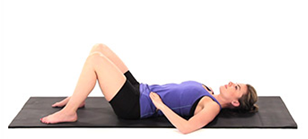
Source – https://s3.amazonaws.com/
How to do Transversus Abdominis exercise?
How to do Transversus Abdominis exercise?
- Lie down on your back on a flat surface with knees bent and feet flat.
- Pull your belly button into your spine and tighten your stomach muscles.
- Do not flatten your back. Breathe normally.
- Hold the position for 5 seconds, and then relax while returning to normal position.
Why do this exercise?
To strengthen the muscles &stabilize your back so that it is protected when exercising your leg.
Hip Flexion Heel Slides
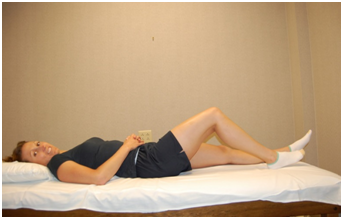
Source – http://3.bp.blogspot.com/
How to do Hip Flexion Heel Slides Exercise?
- Lie down on your back on a flat surface and bring one knee up towards your chest. Do NOT bend past 90°.
- To get some support, you may use a towel behind your thigh. Hold the position for 3 seconds. Relax while returning back to normal position.
- Repeat this 10 times each with both legs.
Why do this exercise?
To help increase movement in the hip joint
Hip Abduction
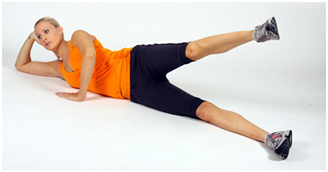
Source – http://golfdashblog.com/
How to do Hip Abduction exercise?
- Lie down on your un-operated side with your legs straight, toes pointed and stomach tucked in.
- Slide up your operated leg towards the ceiling. Keep your kneecap and toes pointed. Keep breathing while you make the leg movement.
- Return to the starting position. Repeat the exercise 10 times twice a day.
Why do this exercise?
To help increase movement in the hip joint
Knee Flexion (Standing)

Source – http://www.universityorthopedics.com/
How to do Knee Flexion Strengthening exercise?
- Stand straight on the leg which is not operated.
- Take a support of wall or table. Keeping your thigh in line with your other leg, bend your operated leg up towards your buttock.
- Hold the position for 3 seconds and repeat it 10 times twice a day. You may gradually add weight on your legs to make it more effective.
Why do this exercise?
To improve your muscle strength and protect your new hip joint
Quadricep Stretch
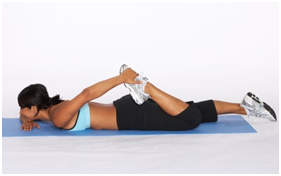
Source – http://s.hswstatic.com/
How to do Quadricep Stretch exercise?
How to do Quadricep Stretch exercise?
- Lie down on your stomach and put a folded towel under your forehead.
- Tighten your stomach and buttocks.
- Using your hand or a towel around your ankle, bend one knee to pull foot up behind you until you feel a stretch in the front of the thigh.
- Do this 5-7 times for both the legs, once during morning.
Why do this exercise?
To make the muscles around your hips more flexible
Wall slides
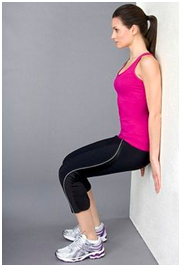
How to do Wall Slides Balancing Exercise?
- Stand straight with back against the wall. Spread your feet shoulder-width apart and approximately 6 inches away from the wall.
- Slowly bend your knees (30-45° maximum) and slide down the wall.
- Hold the position for 3 seconds and slide back up the wall.
- Repeat this exercise for 5 times twice a day.
Why to do this exercise?
To challenge your body with functional activities and improve your balance
Dos and Don’ts to Protect Your New Hip
Do’sto protect your new hip
- Your thigh must remain below the parallel line when compared to the floor.
- When sleeping, use an abduction pillow to help keep legs separated.
- Keep your toes straight ahead or slightly rotated outwards when sitting, standing, or lying.
- To maintain your total hip precautions, work closely with your doctor and physical therapist.
- Do cut back on your exercises if your muscles begin to ache, but don’t stop doing them.
- Use a raised toilet seat.
- Make sure to always stretch slowly after strengthening exercises.
- DO get up from toilet as directed by your therapist.
Don’t stop protect your new hip
- You should not bend your hip up too far or lift your knee too high.
- When lying down, you should not cross one leg over the other.
- You should not rotate your hip inwards, or you may risk a dislocation.
- Do not sit on a low chair or relax with your legs crossed to avoid breaking your hip precautions.
- Don’t try to pick up something on the floor while you are sitting.
- Don’t use pain as a guide for what you may or may not do
- Don’t bring your knee up higher than your hip
- DO NOT sit on chairs without arms.
- DO NOT lie without pillow between legs.
Source Url: https://krsnaphysioplus.com/simple-exercises-manage-hip-joint-pain/
Comments
Post a Comment